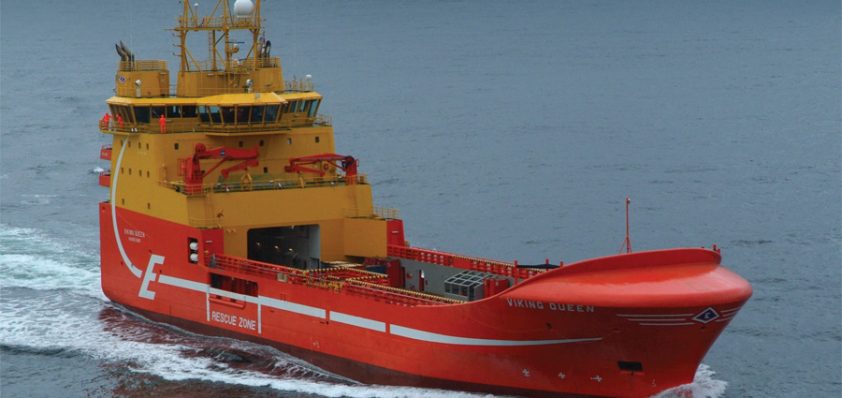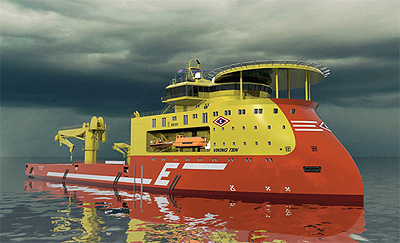
Eidesvik Offshore
Sailing ahead
Eidesvik Offshore ASA is one of the leading suppliers of marine solutions for the offshore industry.
The company was established in 1976 and today operates a flexible and modern fleet of 23 specialised vessels, carrying out work in the worldwide market, within the segments of supply and logistics, subsea, seismic survey and cable laying. A further two seismic vessels are currently under construction and will be delivered in 2010 and 2011 respectively. Several of the vessels in the current fleet have been developed by Eidesvik’s own project department in close co-operation with business associates and naval architects.
 As one of the largest offshore supply vessel owners in Norway, Eidesvik places a strong emphasis on innovation as a key factor in its success. This drive to research unique solutions has given the company an edge over its competitors, and in light of the shift towards environmentally efficient operations in the offshore industry, the company has developed some pioneering eco-friendly offshore solutions. Eidesvik was the first company in the world to launch a support vessel that could run entirelyon LNG – the vessel was developed in response to the Norwegian government’s commitment to considerably reduce NOX emissions by 2010.
As one of the largest offshore supply vessel owners in Norway, Eidesvik places a strong emphasis on innovation as a key factor in its success. This drive to research unique solutions has given the company an edge over its competitors, and in light of the shift towards environmentally efficient operations in the offshore industry, the company has developed some pioneering eco-friendly offshore solutions. Eidesvik was the first company in the world to launch a support vessel that could run entirelyon LNG – the vessel was developed in response to the Norwegian government’s commitment to considerably reduce NOX emissions by 2010.
This vessel has since been followed by two more that run on gas power. They provide a considerable reduction in NOX emissions, and a 20 per cent reduction of CO2, which is the equivalent of around 2000 tonnes per year. Gas is also a less expensive form of fuel from the ship operator’s perspective. Beyond this, the company has also developed a groundbreaking fuel cell power plant, with the intention of becoming the first offshore company to launch a vessel that can run on a fuel cell. This means no NOX emissions at all and a 50 per centreduction in CO2 emissions, as well as lower fuel consumption, when compared to traditional diesel engines that run on marine bunker fuel.
The unique technology behind the fuel cell, known as the FellowSHIP project, has been developed to offer a complete integrated hybrid fuel cell system. It offers numerous advantages over conventional engines, including improved efficiency, and lower operational costs and emission levels. Moreover, fuel cell technology is inherently silent, vibration-free, and it only gives out heat and water. This enhances passenger comfort and improves the working environment of the crew. In 2007 FellowSHIP phase II began with the planning of a qualification test of a 320 kW fuel cell, which is to be used onboard a gas powered PSV. The system provides a versatile solution to cost and emissions concerns, making it an efficient technology for the future.
Over the years, Eidesvik has established a reputation for itself as a leading provider of innovative technology, backed up with an impressive portfolio of pioneering offshore vessels solutions and operations. The first of these was the Geo Explorer, the first 3D vessel in operation, which was launched in 1992. This was followed in 1996, by the largest platform supply vessel in the world, the Viking Lady. 1998 saw the launch of the Viking Poseidon, the first multi-purpose supply vessel (MPSV), and in 2001, the company finished developing a light well intervention vessel (LWIV).  Following Eidesvik’s focus on reducing environmental damage, the first LNG fuelled vessel, the Viking Energy, was launched in 2003 and FellowSHIP was started. Since then several more ship designs have been launched including, most recently, the Viking Queen, the second LNG fuelled vessel.
Following Eidesvik’s focus on reducing environmental damage, the first LNG fuelled vessel, the Viking Energy, was launched in 2003 and FellowSHIP was started. Since then several more ship designs have been launched including, most recently, the Viking Queen, the second LNG fuelled vessel.
In 2004, the company introduced the only supply vessel in existence with the superstructure in the aft position. Traditionally, having the superstructure near the bow leads to a lot of noise and vibration as it is directly over the engines. Also, as there are two steering positions on a standard ship, human error when manoeuvring the boat can become a regular occurrence. The company’s design eliminates these possibilities, whilst providing an atmosphere that is easier and safer to work in, with altogether less noise, vibration and movement.
While environmentally friendly development is central to the company’s innovation programme, it is also aiming to promote safer working conditions for those on board. This has taken the form of a revolutionary new rotation plan for shift patterns. The scheme was originally introduced by the US coastguard several years ago – staff work for eight hours, rest for four and then work for four hours and rest for eight. This replaces the six hours on/six hours off system operated on most supply vessels, which has been known to lead to fatigue and subsequent errors. These new measures, together with improved meals for employees on board and better lighting conditions have meant that Eidesvik is leading the way in terms of enhancing working conditions for its crews, and consequently improving the safety on board its vessels.
In the future Eidesvik is looking at attaining 50 per cent growth across the business, as well as driving towards new technology. The company aims to continue its expansion through increasing the number of vessels in its fleet, and by adding to its portfolio of innovative solutions and technology. This goal is supported by the long-term contracts currently in operation for many of the company’s vessels, providing a good opportunity for Eidesvik to continue its growth in the coming years.
Eidesvik Offshore
Services: Marine operations